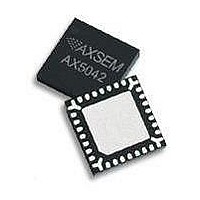AX5042-QFN28-TU AXSEM, AX5042-QFN28-TU Datasheet - Page 28

AX5042-QFN28-TU
Manufacturer Part Number
AX5042-QFN28-TU
Description
RF Transceiver Narrow-Band-IC
Manufacturer
AXSEM
Datasheet
1.AX5042-QFN28-TU.pdf
(45 pages)
Specifications of AX5042-QFN28-TU
Number Of Receivers
1
Number Of Transmitters
1
Wireless Frequency
433 MHz, 868 MHz, 915 MHz
Interface Type
SPI, UART
Output Power
14.5 dBm
Operating Supply Voltage
2.3 V to 2.8 V
Maximum Operating Temperature
+ 85 C
Maximum Supply Current
54 mA
Minimum Operating Temperature
- 40 C
Modulation
ASK, FSK, PSK
Lead Free Status / RoHS Status
Lead free / RoHS Compliant
28
Circuit Description
5.13. Modulator
Depending on the transmitter settings the modulator generates various inputs for the PA:
h
rate; f
ASK
FSK
MSK
therefore f
demodulated more robustly.
GFSK
GMSK
PSK
OQPSK
unless compatibility to an existing system is required, MSK should be preferred.
All modulation schemes are binary.
5.14. Automatic Frequency Control (AFC)
The
to a carrier signal. For AFC adjustment, the frequency offset can be computed with the
following formula:
Version 2.4
AX5042
deviation
Modulation
ASK
FSK/MSK/GFSK
PSK
deviation
has a frequency tracking register
=
= 0.5⋅h⋅BITRATE,
=
=
=
=
=
=
=
= 0.25⋅BITRATE; the advantage of MSK over FSK is that it can be
Bit = 0
PA off
∆f=-f
∆Φ=0
modulation index. It is the ratio of the deviation compared to the bit
amplitude shift keying
frequency shift keying
minimum shift keying; MSK is a special case of FSK, where h = 0.5, and
gaussian frequency shift keying, same as FSK but shaped, BT=0.3
GFSK with h=0.5
phase shift keying
offset quadrature shift keying. The
deviation
0
AX5042
∆
Bit = 1
PA on
∆f=+f
∆Φ=180
f
=
TRKFREQ
deviation
can demodulate signals with h < 4.
0
2
16
TRKFREQ
Main lobe bandwidth
BW=BITRATE
BW=(1+h) ⋅BITRATE
BW=BITRATE
•
BITRATE
to synchronize the receiver frequency
AX5042
.
supports OQPSK. However,
Max. bit rate
600kBit/s
250kBit/s
600kBit/s
Datasheet AX5042















